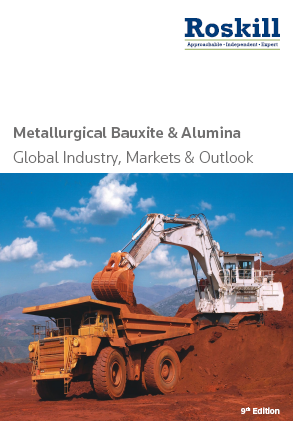 In 2015, China produced just over half of the world’s aluminum and its demand for bauxite has been increasing year-on-year, according to a report from Roskill Information Services. Following Indonesia’s decision to implement a ban on the export of unprocessed ores, China turned to Malaysia in an attempt to fill the void in its bauxite supply. Malaysia’s ability to rapidly increase its output was demonstrated by its production soaring almost 600% from 2014 to 2015. Malaysia represented 45% of China’s imported bauxite in 2015.
In 2015, China produced just over half of the world’s aluminum and its demand for bauxite has been increasing year-on-year, according to a report from Roskill Information Services. Following Indonesia’s decision to implement a ban on the export of unprocessed ores, China turned to Malaysia in an attempt to fill the void in its bauxite supply. Malaysia’s ability to rapidly increase its output was demonstrated by its production soaring almost 600% from 2014 to 2015. Malaysia represented 45% of China’s imported bauxite in 2015.
However, the viability of Malaysian bauxite as a long-term replacement for Indonesian material remains in question, according to a new report from Roskill Information Services. In January 2016, Malaysian officials announced that a three-month moratorium on bauxite mining in the country would be implemented, following increasing environmental fears surrounding pollution of rivers and the sea in the leading bauxite-producing state of Pahang. As part of the ban, the government will certify that mining companies are complying with new operational measures. Those mines that are not operating according to the new guidelines risk not having their approved permits for mining renewed. Exports were granted during the moratorium period to clear stocks and relieve ports of material. A minister suggested that the government would consider extending the ban should mining companies fail to alter their polluting practices.
With concerns surrounding long-term Malaysian bauxite supply and no immediate signals that Indonesia will reverse its export ban, bauxite projects in Vietnam and Guinea are increasingly coming under the spotlight as solutions to this issue.
Vietnam has long been touted as a potential regional supplier of bauxite and alumina. The country is home to the world’s third-largest bauxite reserves, ranked only behind Guinea and Australia, and its geographic proximity to China lies in its favor. However, environmental issues, local objections, and corruption all represent potential barriers to development. The Vietnamese government may also favor “adding value” to its bauxite production by developing further alumina refineries and, in the long-term, aluminum smelters.
Guinea is already an important bauxite producer, exporting 18.9 million tonnes in 2015. However, the country has long been perceived as having potential as an even larger producer of bauxite in the future. Although possessing the world’s largest bauxite reserves, upwards of 7 billion tonnes, its projects remain shackled by a lack of rail infrastructure and port facilities. In July 2015, a 170,000 tonne load of bauxite was shipped from the newly-constructed Boke port. Having completed Bankable Feasibility Studies, Alliance Mining Commodities (AMC) is continuing to develop its Koumbia Bauxite Project, which its hopes, through staged development, could ultimately produce up to 10 million tpy of ore.
Australia still remains the world’s largest producer of bauxite and, in 2015, was the second largest exporter of bauxite ore to China, with 20 million tonnes delivered. Rio Tinto is planning its staggered 50 million tpy Amrun (formerly South of Embley) bauxite project, intended to replace the declining reserves at its Weipa operation. There are a number of other Australian projects, which involve joint ventures and direct offtake agreements with Chinese refiners, which will help to fill some of the Chinese shortfall.
Despite China’s heavy reliance on bauxite imports, the country’s domestic supply should not be discounted. Although its dispersed composition has associated increased processing and energy costs, the bauxite does, however, offer high alumina contents. China may further develop some of these higher-cost resources as a short-term solution to any supply deficits.
The full report, Metallurgical Bauxite & Alumina: Global Industry, Markets & Outlook, 9th edition, can be obtained from the Roskill website.
